The Economics and Statistics Division maintains archives of previous publications for accountability purposes, but makes no updates to keep these documents current with the latest data revisions from Statistics Canada. As a result, information in older documents may not be accurate. Please exercise caution when referring to older documents. For the latest information and historical data, please contact the individual listed to the right.
<--- Return to Archive
For additional information relating to this article, please contact:
October 18, 2023SURVEY OF HOUSEHOLD SPENDING, 2021 Statistics Canada has released the 2021 results of the Survey of Household Spending (no data were collected in 2020). This survey tracks average household spending by a number of categories of current consumption and other expenditures.
In 2021, Nova Scotian households made an average of $60,132 in expenditures for current consumption. This was 89.6% of the national average ($67,126), but above the other Maritime Provinces as well as Quebec. Average household current consumption in 2021 was highest in Alberta and British Columbia.
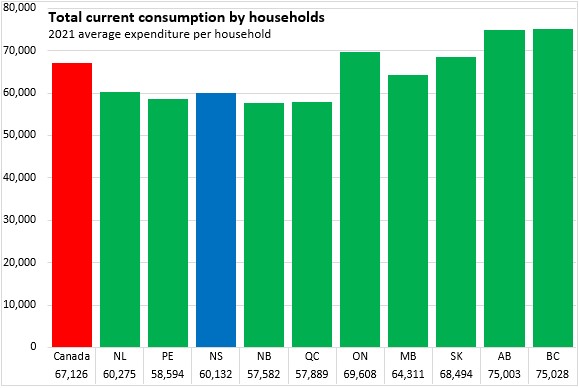
Including tax, insurance, pension, support payments and giving (which are not part of current consumption), Nova Scotia household expenditures averaged $81,522 in 2021 (88.1% of the national average). National household expenditures averaged $92,500 with the highest spending in Alberta and the lowest spending in New Brunswick.
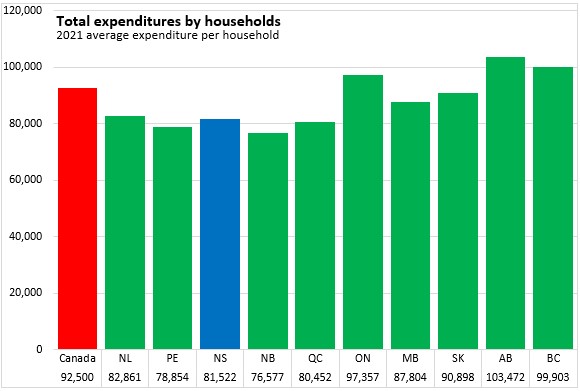
The largest expenditure items in Nova Scotia were income taxes, shelter (including energy and insurance), transportation and food purchased from stores.
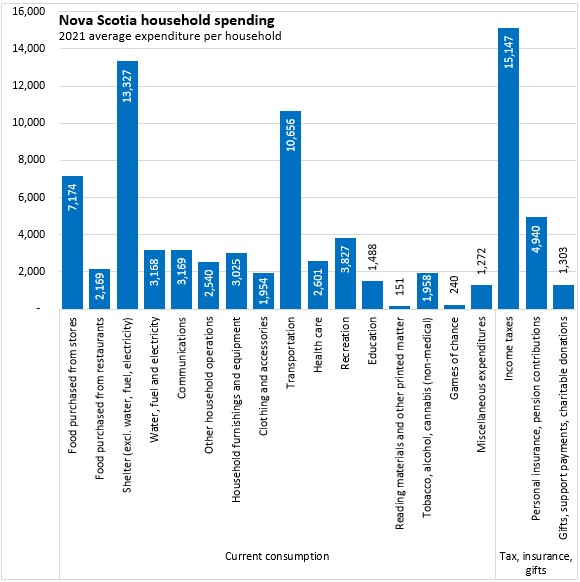
Compared with other provinces, Nova Scotia had the lowest average purchases of food from stores in 2021 at $7,174 per household. The largest specific components of food purchased from stores were meat and dairy/eggs.
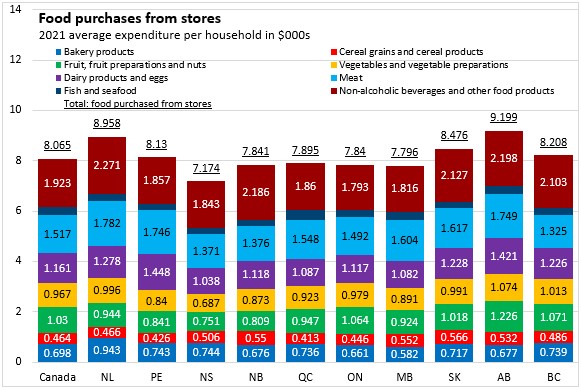
Nova Scotians purchased an average of $2,169 from restaurants in 2021, which was just below the national average. The bulk of these purchases were for meals (as opposed to snacks and beverages).
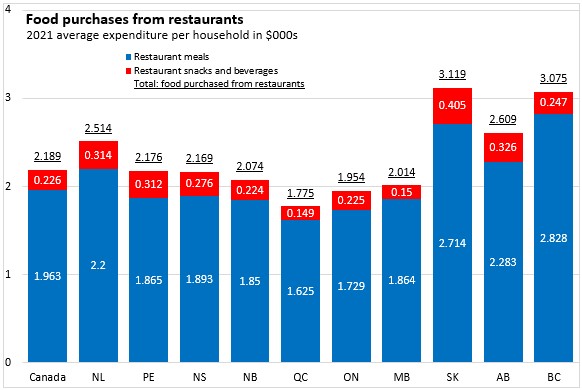
Shelter expenditures averaged $16,495 among Nova Scotia households in 2021. This was 78.2% of the national average. Principal accommodations as well as electricity were the largest items in shelter expenditures.
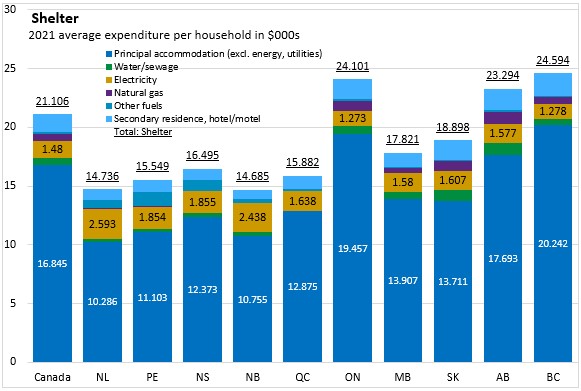
Household operation expenditures averaged $5,709 in Nova Scotia in 2021 - just above the national average ($5,587). The largest items in household operations expenditures were cell phone service, internet service, pet expenses and child care.
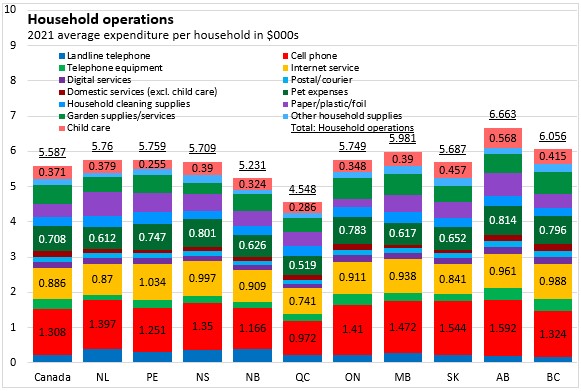
Household furnishing and equipment expenditures averaged $3,025 per household in Nova Scotia in 2021, below the national average. Only households in Manitoba spent less than Nova Scotians on furnishings, appliances and household equipment/services. Expenditures on household funishings, equipment and appliances were notably higher in Ontario and Alberta.
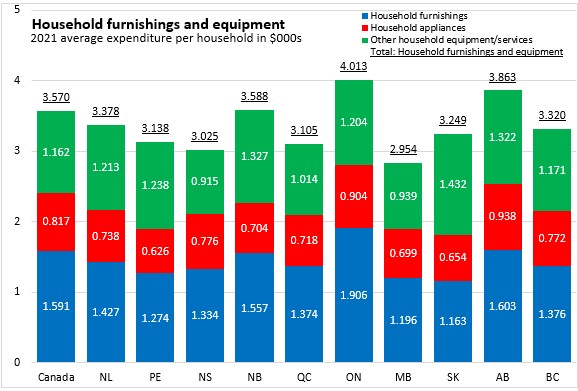
Nova Scotian households spent an average of $1,954 on clothing, footwear and accessories, which was second lowest among provinces (ahead of Prince Edward Island). Clothing was the largest component of this expenditure.
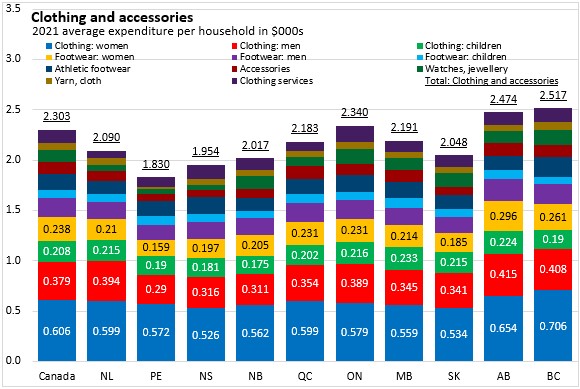
Nova Scotians' transportation expenditures averaged $10,656 per household in 2021, above all provinces in Eastern and Central Canada, but below transportation expenditures in Western Canada. Nova Scotians spent more than the national averages on the largest components of transportation expenditures: vehicle purchase/lease and fuel.
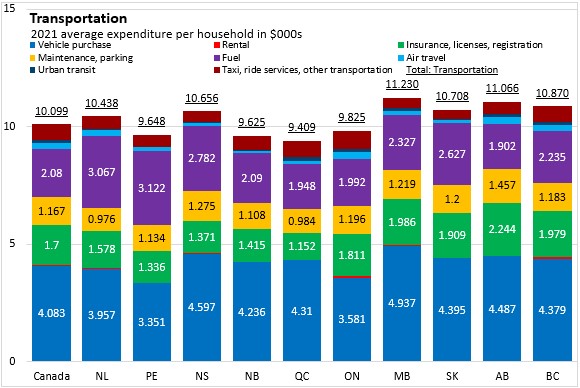
Nova Scotians' average household expenditures on health and personal care were $3,963 in 2021, which was below the national average. Health insurance was the largest component of this expenditure, followed by personal care goods, personal care services, non-prescription medicines and prescription medicines.
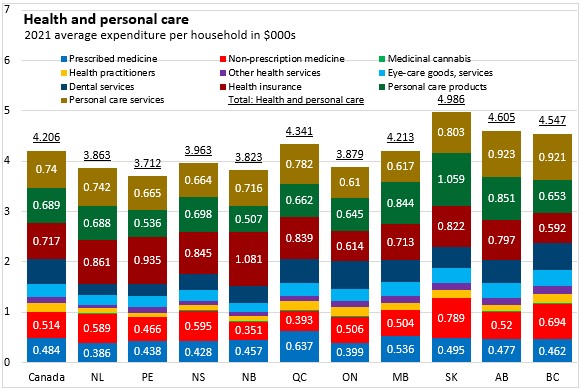
Average household expenditures on recreation were $3,827 in Nova Scotia. The largest items of recreational expenditure were for: recreational equipment (which includes computers), recreational vehicles and associated services, television services, use of recreational facilities and package trips.
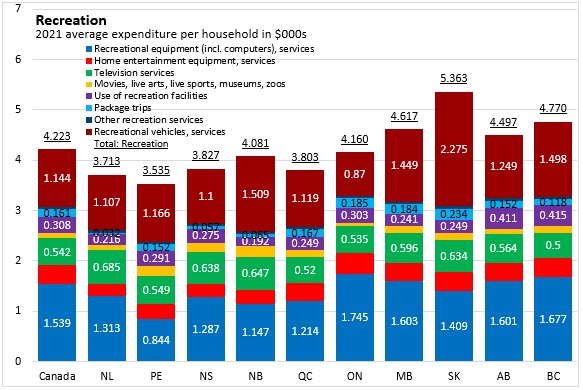
Nova Scotian households spent less ($1,533) than the national average on education and reading materials. The bulk of these expenditures were on education, which includes tuition costs. Education expenditures, including tuition, were notably higher in Ontario, Alberta and British Columbia.
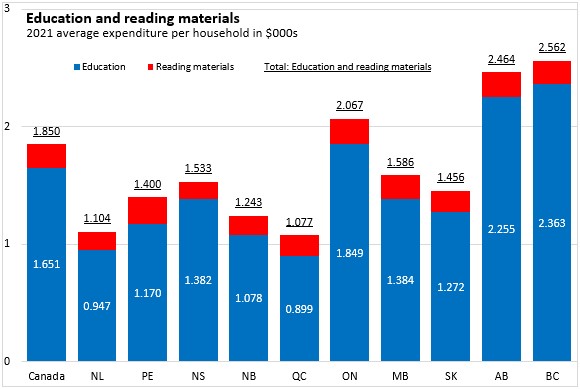
Average household expenditures on alcohol, tobacco, non-medicinal cannabis and gaming were $2,198 in 2021, which was above the national average. Although Nova Scotians spent less than the national average on alcohol, there were higher expenditures in Nova Scotia on tobacco products, non-medicinal cannabis and games of chance (including lotteries).
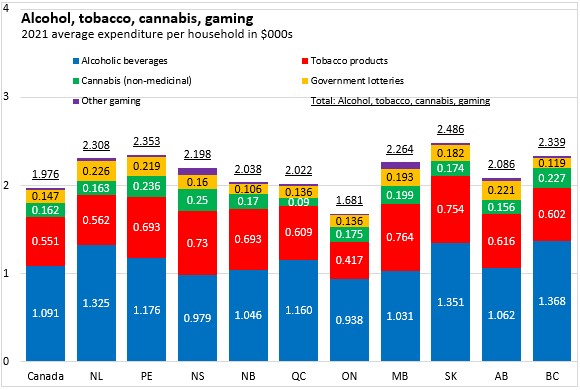
Nova Scotians spend less on average for financial services ($593 per household) and other expenditures ($629 per household), compared to the national average in 2021.
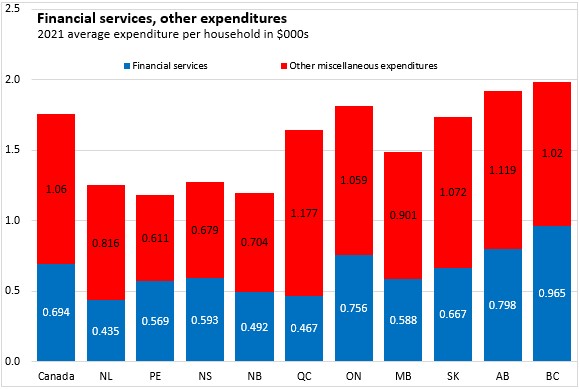
Nova Scotian households paid an average of $15,147 in income taxes in 2021, which was the third lowest in the country (after the other two Maritime provinces). Income taxes paid were highest in Alberta and Ontario.
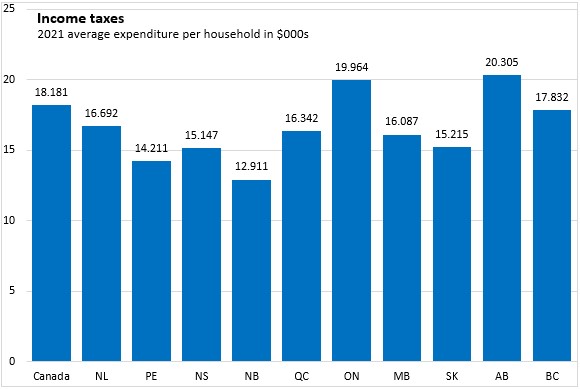
Nova Scotians' average household expenditures on insurance, pensions, giving and child support were $6,243 in 2021, which was below the national average. Retirement/pension savings, gifts of money and charitable contributions were the largest parts of these expenditures.
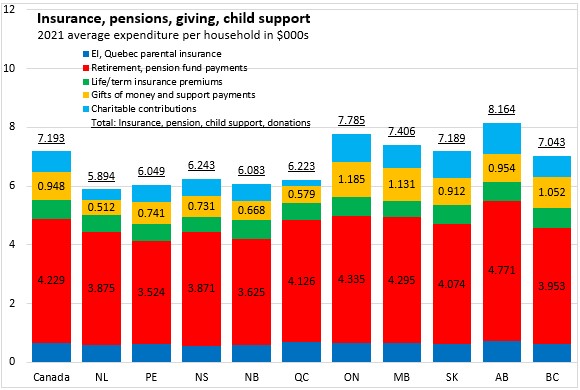
Dwelling characteristics and equipment
In addition to expenditure information, the Survey of Household spending also collects information on Canadians' dwellings and the equipment and services they have.
The 2021 Survey of Household Spending found that 65.5% of Nova Scotians lived in a single-detached dwelling while a further 23.3% lived in an apartment style dwelling.
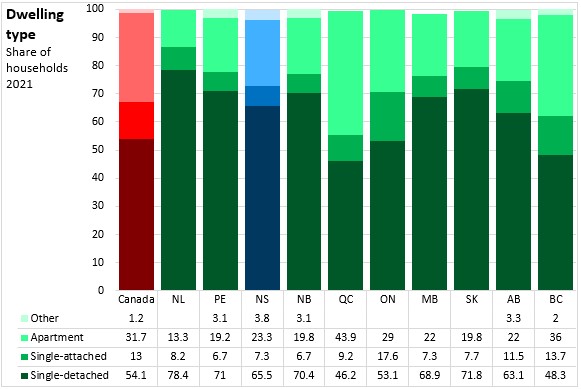
Just over 70% of Nova Scotian households owned their dwelling while 29.6% were renters in 2021. A slightly larger portion of Nova Scotia households (37.7%) had mortgages on their owned dwelling than the share that owned their dwelling without a mortgage (32.7%).
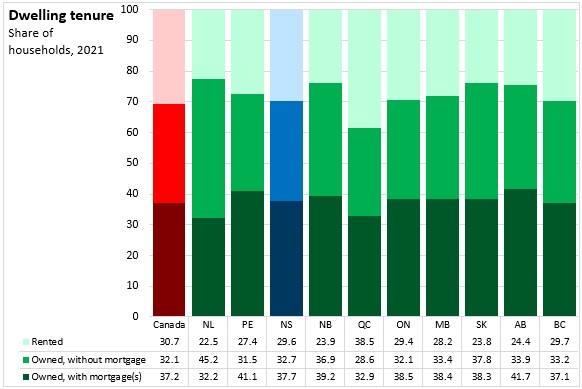
Landline telephone service was less common than households with a cellphone. Over 90% of households in every province had cellular phones while less than half of Canadian households had landline telephone service. In Nova Scotia, 56.5% of households had landlines (which were more prevalent in Atlantic Canada).
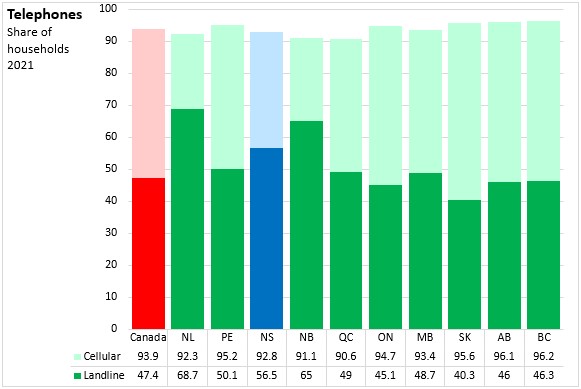
Just over half (50.6%) of Nova Scotia households had cable television in 2021, though a further 16.1% received television service through phone or satellite.
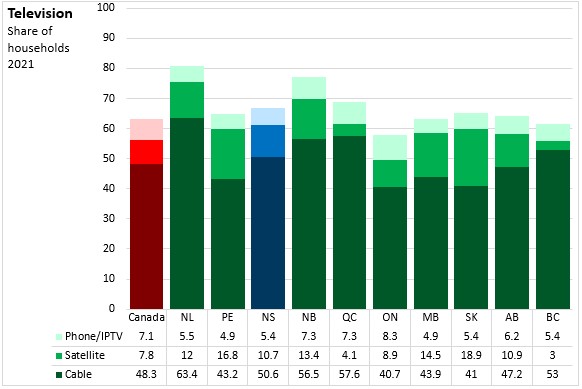
In 2021, 92.3% of Nova Scotia households had internet access. Cable (26.3% of households) and fibre-optic service (40.6%) were the most common forms of internet access in Nova Scotia. Internet access was available at 92.8% of Canada's households.
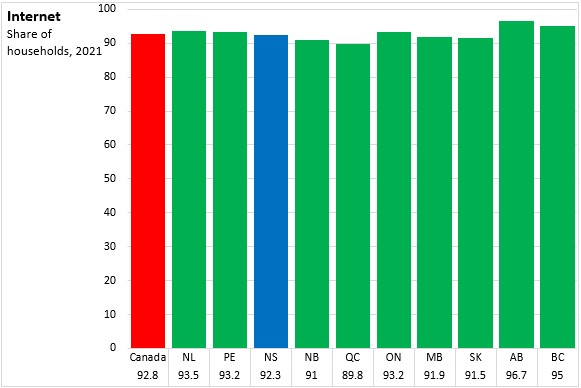
Across Canada, 81.9% of households owned, leased or otherwise operated a vehicle in 2021 including 76.0% who owned a vehicle. The share of Nova Scotia households with a vehicle was higher (86.3%), with 81.5% owning a vehicle. The share of Nova Scotia households that owned 2 or more vehicles was 40.4%, which was above the national average (36.5%).
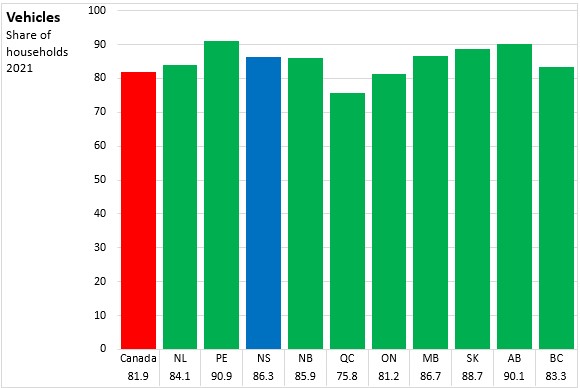
Source: Statistics Canada. Table 11-10-0222-01 Household spending, Canada, regions and provinces; Table 11-10-0223-01 Household spending by household income quintile, Canada, regions and provinces; Table 11-10-0228-01 Dwelling characteristics and household equipment at time of interview, Canada, regions and provinces
<--- Return to Archive